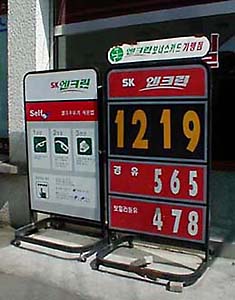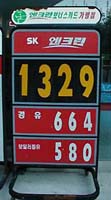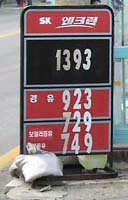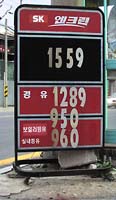







|
The good news, if you're crazy enough to want to own a car in Korea, is that most fuel is cheaper there than
in Europe. The bad news is that it's quite a bit more expensive than in the US, and getting pricier all the time. Forget what the Korea Herald (Korea's English-language newspaper) says about fuel prices. Statistics are OK as far as they go, but these pictures show what people really pay. For years, I shot pictures of the same gas station's sign every time we were in Kangnung (Gangneung). You can see above what's been happening over the years since Margaret started teaching there. Between May and September of 2000, when most of the rest of the world was seeing eye-popping price increases, gasoline prices in Korea rose only 9 percent. But look at the next line down. That's for kyong yoo (light oil, or Diesel fuel). Over the same 4 months it shot up 18 percent. By 2004 gasoline had increased only 14% over May 2000, but diesel was up 63%. Fast-forward to 2006 -- gas is up 28% over May 2000, but diesel fuel has more than doubled. When we next visited Korea in 2014, I didn't manage to get a pic of the same station's sign (sorry). However, we saw gasoline prices running 1800-1850 won per liter, and Diesel prices in the 1600-1700 range. So in the 14 years since our first time in Korea, gas has jumped 50%, and Diesel has more than tripled. What's going on here? Well, Korea has no petroleum. They import all that they use. Their government is tinkering. So far, they haven't exactly managed perfect results.Until the 1980s not many Koreans could afford cars. As they got more affluent and took the plunge, they mostly bought tiny, high-MPG cars. But no more. Gas-guzzling SUVs and vans are now the hot ticket. You might be surprised to hear that the US has something to do with this. In the late 1990s, the American government pushed Korea to cut their purchase and use taxes on large vehicles. Why? Because US automakers wanted to sell in Korea, but US automakers don't make tiny cars.At the time, it wasn't legal to sell small Diesel or LP gas cars to Korea's regular consumers. Now, Diesel fuel produces better mileage, but more smog. LP gas gives lower mileage, but much less smog. Both these fuels were supposed to be used only in commercial vehicles. Both were made extra cheap (the Korean government set the prices). Korea's automakers figured out that by selling big trucks instead of cars, they could build them to use Diesel or LPG. (Sounds a lot like what the US automakers did here.) But there wasn't any point, since nobody could afford them - until the US came along and twisted Korea's arm. With the taxes reduced on 7-passenger SUVs, it didn't matter (to the owners) that they got half the mileage, because the fuel was half the price. If you didn't peek, you can guess what happened. The Korean government is trying to patch things up. Since 2005 it's been legal to sell small cars that run on Diesel fuel. They've raised the price on Diesel fuel drastically. They probably thought that would get some Koreans back into small cars. But by that time they were used to big SUVs and vans, and they didn't want to give them up. I didn't see many more small cars when we were there in 2014. Korea's air hasn't gotten any less murky that I can tell, either. By the way, how do you suppose gas stations compete when the government regulates the price? On "service." The Korean concept is a little different from ours, though. We'd say "service" means washing the windows, checking the oil, maybe putting air in the tires. But in Korea "service" means a free bonus. Want a pack of Kleenex with that fillup?
|